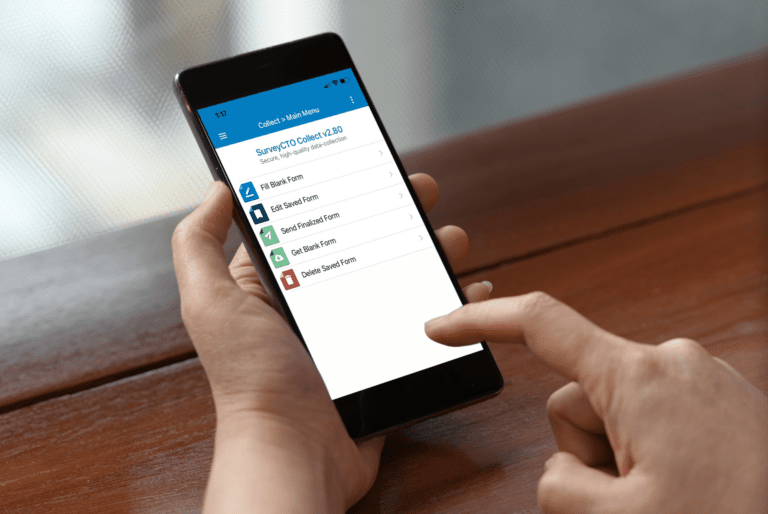Practical solutions for common fieldwork challenges to make your offline data collection more productive and impactful
There are real, difficult barriers to development organizations getting the high-quality data you need when you’re collecting data in the field. Organizations often find themselves lacking in these areas: Resources, logistical planning, reliable Internet access, positive relationships with locals, and data collection technology. And this can mean inaccurate or incomplete data.
However, the good news is that there are steps your organization can take to tackle these challenges and collect better data in the field!
If you haven’t already, check out Part 1 to get an overview of common challenges. Then, dive into this post to find solutions!
1. Use technology to do more with less and eliminate problems.

Use digital tools that provide features that match your data collection methods and needs. For example, if you conduct computer-assisted telephone interviews (CATI), look for tools with convenient, built-in features for phone surveys.
- Go digital. Using pen and paper is still popular in fieldwork, but the time and effort involved eats up a huge amount of resources. You can easily decrease the time your data collectors spend in the field by multiple days simply by switching from pen-and-paper (PAPI) to a mobile data collection tool and using computer-assisted personal interviews (CAPI) or computer-assisted telephone interviews (CATI) as your data collection method. By reducing the length of time it takes to do each survey, it’s also much easier and less fatiguing for fieldworkers to complete the number of surveys needed to stay within budget.
- Get a tech stack. A full tech stack for streamlined, efficient data collection typically involves platforms for data management, analysis, reporting, and visualization. While many teams rely on basic methods like Excel spreadsheets for all of their data management needs, you can save an incredible amount of time in data exporting, cleaning and analysis by using digital tools that are designed for exactly those tasks. Pro tip: Be sure your tools integrate with each other for maximum flexibility and interoperability!

2. Make a plan.
Invest in real project planning before going into the field. Start with in-depth research on what you need to know about your local area. Make sure you consider many different factors, including physical ones like geography and climate, to culture-based ones like local religion, customs, and gender roles. Keep local holidays and events in mind, and pay attention to what’s happening politically and socially in the region your fieldwork will take place in.
Alongside gathering logistical information, there are other best practices you can follow when planning for fieldwork:
- Time. Give your team enough time to prepare, design your study and adequately test your questionnaire. This up-front investment will save time in the long run.
- Pilot your survey in the area you’ll be working in. This means run your survey with a small number of enumerators and respondents prior to actually conducting the survey on your entire sample. It’s so much easier to pilot and find as many issues as possible ahead of time, instead of having bad data and then having to go back and recollect.
- Improve. Learn from your pilot, and make changes to your survey or project plan as needed.
- Use quality checks. Be sure to use a mobile survey application that lets you set up data quality checks that can run in real time during the duration of your fieldwork. Review your checks often, so that you know if there are any problems with your survey as soon as possible.
3. Get smart about working offline.
Unreliable Internet happens, but it doesn’t mean relying on pen and paper (remember, you want to save time and resources with a digital tool). Today, you can find an offline data collection app designed for data collection in areas with no Internet connectivity, letting you easily run offline surveys and data collection workflows.
A few best practices for using tools with these features:
- Work ahead. If possible, enable all needed offline features in your workflow prior to going out into the field.
- Train for offline situations. Make sure enumerators know what to do (if they need to do anything) when their Internet access changes. For example, do they need to enable offline functionality on their device if WiFi cuts out during an interview? Repeat their last three questions to ensure continuity? Are there circumstances where they should transfer cases from their own device to a colleague’s to complete the interview at another time? Even if you think you’ll have the Internet during data collection, include training for offline scenarios. Similarly, if you’re training for an offline environment, it’s also important to provide some training for using the Internet strategically when available, too. For example, enumerators will need to sync with a server at some point to submit their data, so training them on how to do this is critical. If possible, designate a place for enumerators to sync data, like a local Internet cafe or a mobile hotspot, and set a schedule of when this should happen.
- Always test. If you’re piloting, test the offline features (even if you have current access to WiFi) by switching it off on enumerator devices to ensure that everything is working correctly.
- Don’t assume things can’t change. Internet access is subject to change in the field. If you are collecting data in cities and the WiFi has been strong during your pilot, but you know that the Internet can be unreliable in the country you’re working in, it’s best to err on the side of caution and enable offline functionality just in case.

4. Invest in local relationships. Build trust.
Investing time getting to know local contacts. Learn and respect their culture. Ask their opinion!
Provide the data collectors you hire from local communities with high-quality training that ensures they are familiar with all survey protocols and procedures, and understand best practices for CAPI or CATI surveys. If you can, involve local enumerators in the design of your data collection forms to provide invaluable insights from their personal knowledge of the issues their community faces that you are measuring. You can further help enumerators out by choosing a user-friendly digital tool, and setting up their devices for them ahead of time, so they don’t need to worry about managing unfamiliar technology on their own.
Marta Costa and Amber Liskey are part of Team SurveyCTO’s customer support, and have extensive personal experience in offline fieldwork. They advise field teams to build trust with enumerators by getting to know them personally.
Amber notes that it’s important to “Maintain relationships that are not just work focused. This takes a little bit of energy outside of your regular responsibilities. Maybe send a WhatsApp message and say hey, how’s your family? I have worked with enumerators who live in conflict zones, and just checking in and making sure everything is okay can go a long way in making the working relationships so much better.”
Marta says that field team managers also need to understand that ultimately, managing people is a big part of their job, even if their focus is on the survey. “Ultimately, enumerators need the same support that we do and that anyone does when working for an organization. Sometimes, people are thinking, “We just need the data!’’ But these enumerators are people that are working so hard in such difficult situations and contexts. It makes a lot of sense to build trust and relationships with them.”
Implement solutions for your fieldwork challenges and get better data today
When you solve your data collection challenges, your data gets better in a variety of ways:
- Utilizing digital data collection tools frees up precious limited resources for survey design, project planning, and piloting. It also gives hardworking enumerators more bandwidth, leading to better-quality interviews. And, it gets rid of the many security and quality concerns that accompany manual data collection methods.
- Strong planning helps avoid problems in the field, like running surveys at poor times, or not having transportation for enumerators. Including data quality checks in your survey plan lets you catch errors quickly and solve fieldwork issues faster.
- Being offline-ready reduces disruptions to enumerators and respondents during data collection. It also ensures that data is never lost during collection due to sudden Internet outages.
- Building trust with locals and enumerators means you’ll have assistance with the unexpected in the field. Inviting local perspectives to inform your survey design will capture richer, more nuanced data. And enumerators trained in best practices for in-person data collection will introduce less bias into interviews, giving you more accurate insights.
Good data = good decisions. Want actionable insight into your beneficiaries, programs and projects? Know the challenges of fieldwork and how to address them to start collecting your best data ever.




